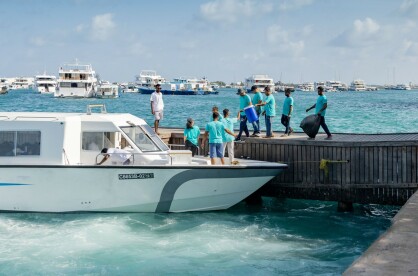Our flailing healthcare system
With the high spending on healthcare in the Maldives, the outcomes should be more significant.

Treetop Hospital
With the high spending on healthcare in the Maldives, the outcomes should be more significant.

Treetop Hospital
Healthcare has always been a topic of utmost importance in the Maldives and using it to bolster manifestos is a common approach during voting seasons. While the numbers may indicate a very optimistic outlook, the reality is, unsurprisingly, very different.
As at the end of 2019, the Maldives had over 190 health facilities, out of which 4 were privately owned. Immunisation, the cornerstone of a healthy community, has been done extremely well, eradicating multiple diseases along premeditated timelines and targets. As of 2016, the Maldives' spending on healthcare was at 12 percent of GDP, compared to 4 percent in India.
In addition, with the introduction of Husnuvaa Aasandha, out-of-pocket expenditure on healthcare is at a record low, which on the face of it is proof that health care affordability has been improved by the state. Yet, why is the public still unsatisfied with healthcare services in the Maldives?
The birthrate in the Maldives has declined over the past decade, and the increase in life expectancies and changes in lifestyles have meant that the disease profile in the country has also changed. The Ministry of Health reported that in 2019, 55 percent of deaths and 11 percent of hospitalisations was due to chronic conditions – meaning that there is an increasing need for tertiary care health facilities. Currently, there are three such facilities in the country, all in capital Malé. This has implications in that there is a need to travel to Male for all cases requiring specialist scans and services.

Aisha* lives in Nolhivaranfaru. She must come to Malé for checkups every six months because the hospitals near her island do not have the necessary equipment or specialists. She is lucky that she has friends in Malé who she can stay with, so her costs are a bit lower than most in the same situation.
The government has announced and started implementing a project to establish five tertiary care hospitals across the country, and the addition of two more by February 2021, which is commendable. Minister of Health Ahmed Naseem, in November 2020 had said that the objective of the government for the health sector is to decentralise the provision of services and to remove itself from actual service provision to be more of a policy-setting and regulatory body. In September 2021, however, Vice President Faisal Naseem, in a meeting with health sector officials, underscored the importance of prioritising the recruitment of health care workers in preparation for the establishment of the five tertiary hospitals. The focus on health care professionals and capacity building, however, appears to be a tad late – better late than never though.
Ali* went to an eye clinic in capital Malé with what looked like conjunctivitis. He was given a drop for this, which he applied religiously. When he woke up the next morning though, his condition appeared worse! He goes back to see a different doctor at the same clinic, where he was told he had been prescribed an anti-bacterial drop whereas he should have been prescribed an anti-viral.
The World Health Organisation (WHO) recommends that there be at least one doctor per 1,000 people. Perusing the information available from the Ministry of Health, however, it appears to be deficient in the Maldives – in the larger population centres, such as Seenu and Alifu Dhaalu Atoll, the ratio was at 0.8 and 0.7 respectively in 2019, while in Kaafu Atoll, including Malé, it was at a mere 0.3 per 1,000 people. This perhaps explains the many reports of patients having to wait, sometimes for months, to see a specialist doctor or to avail treatments. A recent news report said that more than 10,000 people in are on the waitlist at main IGMH in Malé to see a specialist doctor.
Then there is the story of how Amina* learns that her 80-year old grandmother, who has had a stroke, is advised to remain at home because it is a Friday and doctors are not available.
Another concerning factor is the high expenditure through Husnuvaa Aasandha to send patients abroad for specialist medical treatment – not counting those with the means to go abroad for treatment who do not avail Aasandha. A report published by the Ministry of Finance states that sending patients abroad is the second largest component of Aasandha expenditure. For a country that spends a proportion on healthcare on the same footing as a developed country, and one with the highest GDP per capita in the region, to have to send so many of its citizens abroad to neighbouring countries is a point worth pondering. And bares the truth of the inefficiency that is rife in this sector.
Kaiydha* consulted a doctor in one of the main hospitals in Malé. She was told she had no option but to remove her uterus – to remove a cyst that the doctor said was very risky and may lead to excessive bleeding. She could not accept the treatment plan and looked at other options. She was lucky enough to be able to travel to a neighbouring country without having to depend on Aasandha. The treatment there? A one-day procedure to just remove the cyst, without the need to have major surgery.
According to a budget document published by the Ministry of Finance, the largest component of Aasandha expenditure, at an annual expenditure of MVR500 million, in on the reimbursement of medicines. The report says that the rapid increase in this component is due to the heavy reliance on branded medicines rather than the generic and cheaper versions of the same medicines. Compare this to reports of basic over-the-counter medicines still not being available in some islands.
For a country heavily reliant on tourism, the high level of spending on the health sector with no actual and quality results is worrying, and also highly unsustainable. Healthcare is no longer a privilege but a right, and needs to be provided on an equal footing for the populace. While health sector funding is not expected to lessen, further checks, balances and restructuring is needed urgently, to ensure efficiencies and outcomes.
* Denotes where names have been changed.



